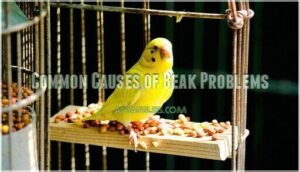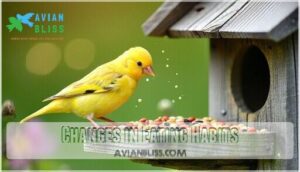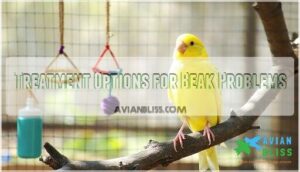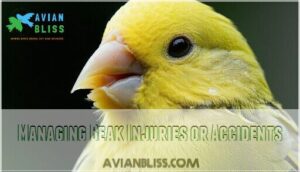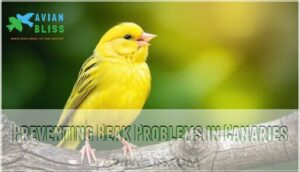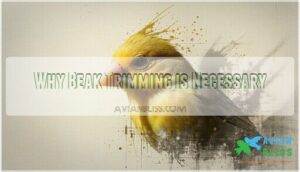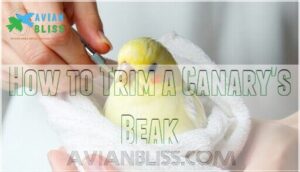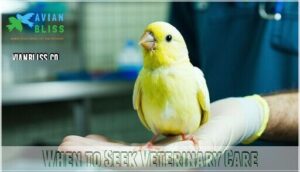This site is supported by our readers. We may earn a commission, at no cost to you, if you purchase through links.

You’ll need to check for overgrowth, injuries, or infections like scaly mites. For minor overgrowth, provide cuttlebone or mineral blocks to help natural wearing.
Infections require vet-prescribed medications, while injuries might need gentle cleaning with avian antiseptic.
Boost your bird’s diet with calcium-rich foods and vitamin supplements to strengthen their beak naturally. Like human fingernails, healthy beaks need regular maintenance.
Just remember, when your feathered friend’s "tool" is in good shape, they’ll be back to chirping and cracking seeds in no time.
Table Of Contents
- Recognizing Beak Problems in Canaries
- Common Causes of Beak Problems
- Symptoms of Beak Problems in Canaries
- Diagnosis of Beak Problems
- Treatment Options for Beak Problems
- Dietary Changes for Beak Health
- Managing Beak Injuries or Accidents
- Preventing Beak Problems in Canaries
- Beak Trimming and Shaping
- When to Seek Veterinary Care
- Frequently Asked Questions (FAQs)
- What happens if a canary’s beak is overgrown?
- How to help a sick Canary?
- Why do canaries need a balanced diet?
- How can canary owners protect their birds from a viral infection?
- How do you keep a canary bird healthy?
- How do veterinarians treat beak surgery?
- What does an unhealthy bird beak look like?
- How do you treat an overgrown beak?
- What does beak disease look like?
- Is beak trimming painful for birds?
- Conclusion
Recognizing Beak Problems in Canaries
You’ll spot beak problems in your canary by watching for changes in color, shape, or texture that weren’t there before.
Beak changes in color, shape, or texture are your canary’s way of signaling it’s time for a health check.
Just like you’d notice if your favorite shoes suddenly looked worn out, your feathered friend’s beak health gives important clues about their overall wellbeing.
Changes in Beak Color
A color shift in your canary’s beak often signals trouble brewing.
This change might stem from nutritional deficiencies, infection indicators, stress, or genetic discoloration.
When your bright-beaked friend suddenly shows pale or unusual coloration, it’s nature’s warning system at work.
Regular monitoring helps catch these canary beak problems early.
Age-related changes happen naturally, but sudden transformations deserve attention.
Don’t ignore this visual clue to your bird’s health, as it can be a sign of underlying issues, and regular monitoring is key to catching problems early.
Changes in Beak Shape
While color changes offer one clue, your canary’s beak shape tells another important story.
Watch for these warning signs:
- Overgrown beak: Often caused by liver disease or nutritional imbalances
- Scissor beak: Common deformity type where upper and lower don’t align
- Crossed beak: Genetic factors often contribute to this shape
- Abnormal curves: May require shaping techniques by an avian veterinarian
- Rapid growth: Signals potential health problems
Regular checks can prevent serious beak deformities.
Cracks and Chips in The Beak
You might spot small cracks or chips in your canary’s beak—these aren’t just cosmetic issues.
The crack severity can range from minor to serious, with higher infection risk in deeper fractures.
Beak trauma often stems from accidents or nutritional deficiencies.
For home remedies, guarantee proper nutrition and safe perches.
Consider repair options like filing smooth edges, but don’t delay seeking help for beak injuries or fractures that affect eating, as this can lead to serious health issues, including infection risk.
Discharge or Odor From The Beak
During your regular health checks, watch for unusual discharge or odor from your canary’s beak – these are red flags of infection.
Two warning signs you shouldn’t ignore:
- Colored discharge (yellow, green, or white mucus) indicating respiratory infections
- Foul smell from the beak area suggesting bacterial growth
These beak infection signs require urgent veterinary attention. Don’t wait – proper canary beak odor treatment prevents more serious complications.
Common Causes of Beak Problems
You’ll need to understand what’s causing your canary’s beak problems before you can fix them.
From poor nutrition to injuries, infections, and genetic factors, identifying the root cause will help you choose the right treatment for your feathered friend, which is crucial for applying the right treatment.
Poor Nutrition
After spotting unusual beak problems in your canary, poor nutrition often stands as the primary culprit.
Seed-only diets create serious vitamin deficiencies and mineral imbalances that weaken your bird’s beak structure. You’ll notice discoloration, softening, or abnormal growth when malnutrition takes hold.
Boost your canary’s diet with fresh vegetables, calcium supplements, and specialized pellets to restore proper beak health and prevent future problems. A balanced diet helps prevent soft or overgrown beaks.
Don’t wait until dietary damage becomes permanent, as a balanced diet is crucial for maintaining your canary’s overall health, including preventing beak problems, and ensuring your bird’s well-being is properly maintained.
Injuries or Accidents
Beyond proper nutrition, physical harm poses serious risks to your canary’s beak. Even small cage mishaps can lead to devastating results.
Protect your feathered friend by addressing these danger zones:
- Sharp Objects: Remove anything that could cause beak fractures or punctures
- Cage Design: Check for gaps where beaks might get caught causing avulsions
- Other Pets: Prevent beak detachment injuries from animal attacks
- Emergency Kit: Include gauze pads for bleeding until beak surgical repair
Remember, damaged beaks can be fixed!
Infections or Diseases
Infections or diseases can quickly damage your canary’s beak.
While injuries heal naturally, bacterial infections, fungal infections, and viral infections like Avian Pox require prompt treatment.
Watch for increased beak scratching, which may signal psittacosis or other conditions.
If your bird shows eating problems or discoloration, contact a vet immediately.
Most infections respond well to antibiotics or specialized treatments, but early detection is key to successful canary beak problems treatment.
Genetics or Hereditary Conditions
Some canary beak problems stem directly from your bird’s family tree. Genetic factors can cause inherited deformities that affect beak shape and function.
To address genetic predisposition in your canary:
- Consider genetic testing to identify inherited disorders before they worsen
- Review family history when selecting breeding pairs
- Monitor offspring for early signs of beak abnormalities
Don’t blame yourself—these predisposition factors aren’t your fault, but understanding them helps provide better care.
Symptoms of Beak Problems in Canaries
You’ll spot beak problems in your canary before they become serious if you know what signs to watch for.
Your feathered friend might show changes in eating habits, unusual droppings, weight fluctuations, or sudden behavior shifts that can tip you off to trouble brewing with their beak.
Changes in Eating Habits
Your canary’s dinner habits can reveal hidden beak problems that need attention.
Watch for these warning signs:
| Eating Behavior | Common Causes | Treatment Action |
|---|---|---|
| Food Refusal | Pain when eating | Soften food, visit vet |
| Decreased Appetite | Swallowing Difficulty | Try smaller seeds |
| Selective Eating | Beak discomfort | Dietary changes |
| Regurgitation Signs | Infection/injury | Immediate vet care |
Is your feathered friend taking longer to finish meals? Like people with toothaches avoiding certain foods, canaries with beak problems develop specific canary eating habits.
Early detection of these changes means faster canary beak problems treatment and a happier bird.
Changes in Droppings
While watching your canary’s eating habits, don’t forget that droppings analysis is equally telling.
The poop scoop: changes in color, consistency, or smell often signal digestive issues linked to beak problems.
Green droppings might indicate infection signs, while watery ones suggest poor hydration levels.
Track your canary’s droppings daily—they’re like tiny health reports that reveal diet correlation and potential illness signs before they become serious.
Weight Loss or Gain
While monitoring your canary’s droppings, don’t overlook weight fluctuations – they’re often linked to beak problems.
Sudden weight loss may indicate muscle atrophy from difficulty eating, while weight gain might reflect metabolic disorders.
Watch for changes in calorie intake or dietary absorption issues.
Underlying illnesses affecting the beak can disrupt normal feeding patterns.
When your feathered friend’s weight shifts unexpectedly, it’s time to consult an avian vet about potential beak health concerns.
Changes in Behavior
Beyond weight changes, your canary’s behavior speaks volumes about possible beak problems.
You’ll spot these telling signs:
- Reduced Activity: Your once-lively bird now sits fluffed up like a little cotton ball
- Feather Plucking: More than normal preening, this signals distress
- Silent Treatment: Sudden decrease in singing or chirping
- Withdrawal: Your social butterfly now avoids interaction
These behavioral changes often mean your canary’s experiencing beak discomfort that needs attention.
Diagnosis of Beak Problems
You’ll need to spot beak problems early by checking your canary’s beak for changes in color, shape, or texture during your regular "beak inspections" (yes, that’s a thing bird owners do).
Getting a proper diagnosis often involves a trip to the vet who’ll look at your bird’s medical history and possibly run tests to find out what’s really ruffling your feathered friend’s feathers.
This process is crucial for maintaining your bird’s health, and understanding the importance of regular check-ups can make a significant difference in their well-being.
Visual Inspection
After observing your canary’s symptoms, it’s time for a close-up inspection of their beak.
Look at your bird’s beak color—is it pale or showing unusual discoloration? Check for shape abnormalities or asymmetry between upper and lower portions.
Run your eyes over the texture—any peeling, flaking, or softening? Don’t miss small lesions or pitting that might hide infections.
Be aware that issues like beak discoloration signals underlying health problems. These visual clues help catch problems before they worsen.
Medical History
While visual inspection shows what’s happening now, your canary’s medical history reveals the full story behind beak problems.
Your bird’s records help avian veterinarians connect the dots by tracking:
- Previous illnesses that might affect beak development
- Genetic predispositions common in certain canary bloodlines
- Medication history that could impact keratin formation
- Dietary background revealing possible nutritional deficiencies
Environmental factors also play a role. Did your canary previously live in a different cage setup? This context gives your vet vital insights for proper diagnosis, considering the full story and previous illnesses to make an informed decision.
Laboratory Tests
Five critical laboratory tests help diagnose your canary’s beak problems properly:
- Blood tests check organ function and rule out underlying health issues
- Fecal tests identify parasites that might be causing beak changes
- PCR testing of blood, swabs, and feather samples detects disease-causing organisms
- Skin or feather biopsies can diagnose conditions like PBFD (Psittacine Beak and Feather Disease)
- ELISA testing confirms the presence of specific antibodies related to beak diseases
Your vet will choose the right tests based on your bird’s symptoms.
Don’t worry—most samples are tiny and cause minimal stress.
These tests are like detective work that solves the mystery of your canary’s beak troubles!
Treatment Options for Beak Problems
You’ll find several effective treatments for your canary’s beak problems, from simple dietary fixes to medication and professional trimming.
Don’t worry if your feathered friend’s beak looks a bit off—with the right approach, you can help your canary get back to singing and snacking happily in no time.
Dietary Changes
Transforming your canary’s diet is the cornerstone of treating beak problems.
A balanced mix of seed variety, calcium sources like cuttlebone, and Vitamin A-rich greens can strengthen weakened beaks.
| Nutrient | Source | Benefit |
|---|---|---|
| Calcium | Cuttlebone, mineral blocks | Strengthens beak structure |
| Vitamin A | Dark leafy greens, carrots | Prevents flaking, promotes healing |
| Protein | Soft foods, egg food | Supports keratin production |
Nutritional deficiencies often underlie canary beak problems—proper nutrition is your first defense.
To further support beak health, consider providing natural wood perches in the cage.
Medication or Supplements
While good nutrition is your first line of defense, medications and supplements play a key role in canary beak treatment.
- Antibiotics fight bacterial infections causing beak scratching
- Antiparasitics target parasites linked to discoloration
- Probiotics restore gut health after medication
- Antihistamines help manage allergy-related scratching
- Multivitamin preparations address Vitamin A and calcium deficiencies
Your vet can recommend the right combination of these treatments to support your canary’s beak health.
Some owners purchase beak antibiotics for treatment.
Surgery or Beak Trimming
While supplements can support beak health, sometimes surgical intervention becomes necessary.
When your canary’s beak grows unevenly, professional trimming or surgery might be the only solution. Never attempt to trim your bird’s beak at home – a veterinarian should handle this delicate procedure.
| Procedure Type | When It’s Needed | Potential Risks |
|---|---|---|
| Beak Trimming | Overgrowth | Bleeding if cut too short |
| Corrective Surgery | Severe malformation | Anesthesia complications |
| Prosthetic Application | Fractured beak | Adjustment period |
| Splint Installation | Mild deviation | Stress on bird |
| Reconstructive Surgery | Major trauma | Extended recovery time |
Remember, proper post-op care is essential after any beak surgical treatment. Your avian vet can guide you through recovery to prevent complications.
Dietary Changes for Beak Health
You’ll be amazed at how quickly your canary’s beak health can improve with the right food choices, just like how humans feel better after swapping junk food for nutritious meals.
What you put in your bird’s dish directly affects their beak strength and structure, so making smart dietary changes now can save you both from painful problems later, which is why choosing the right food is crucial for your bird’s overall health and well-being.
Providing a Balanced Diet
A balanced diet works like medicine for your canary’s beak health.
Mix these key elements for best results:
- Essential nutrients from a quality seed variety (millet, canary seed, nyjer)
- Fresh foods like leafy greens and carrots for vitamin A
- Calcium sources such as cuttlebone or mineral blocks
- Vitamin supplements specifically formulated for birds
- Daily fresh water to prevent dehydration
This balance prevents common canary beak problems while supporting overall health.
To further support beak health, consider providing conditioning with perches.
Avoiding Nutrient-Deficient Foods
Now that you’ve established a balanced diet for your canary, let’s focus on foods to avoid that could harm their beak health.
Steer clear of low-quality seed mixes lacking Vitamin A sources – they’re a recipe for beak problems. Many commercial mixes contain empty fillers with minimal nutritional value.
Your canary’s beak needs calcium-rich foods to stay strong, so avoid diets heavy in just one type of seed. Remember, nutritional deficiencies show up in the beak first.
Include fresh produce variety daily to prevent vitamin deficiency beak issues.
Adding Supplements or Vitamins
Beyond good foods, your canary may need targeted supplements for ideal beak health.
Vitamin deficiencies often show up first in the beak’s condition.
- Vitamin A supplements prevent dryness and flaking in beaks
- Calcium sources with D3 supplementation strengthen beak structure
- Zinc benefits include maintaining keratin production for proper beak growth
- Copper intake supports melanin formation for normal beak coloration
Don’t overdo it though—excess supplements can harm your little singer.
Consider beak supplement options for your bird.
Consult your vet before adding any multivitamin preparations to your canary’s diet to ensure the best beak health and avoid potential harm from excess supplements.
Managing Beak Injuries or Accidents
When your feathered friend has a beak mishap, you’ll need to act quickly to prevent complications and ease their discomfort.
You can manage most minor beak injuries at home with the right cleaning techniques and gentle care, but don’t hesitate to call your vet if the damage looks serious or your canary stops eating, as this can lead to further complications.
Cleaning and Disinfecting The Beak
After noticing any beak injury, proper cleaning is your first defense against infection.
Use safe disinfectants like diluted povidone-iodine solution on a cotton swab to gently clean damaged areas.
Maintain cleaning frequency of 1-2 times daily until healing begins.
Natural cleaners like diluted salt water work well for minor issues, and always use cotton swabs or soft cloths as cleaning tools to prevent further trauma to sensitive beak tissue.
Applying Topical Treatments
For minor beak injuries, applying topical treatments can speed healing and prevent infections.
Use only vet-approved antibiotic ointments or antifungal creams designed for birds. Apply with a clean cotton swab using gentle, precise movements. Don’t overdo it—a thin layer is enough!
Monitor progress daily, looking for signs of improvement or complications. You can find specialized beak care products online.
With proper wound care and application techniques, most beak problems like scratches or mild discoloration respond well to consistent treatment.
Providing Pain Relief
After cleaning your canary’s injured beak, pain relief becomes your next priority.
You can use vet-prescribed analgesic options specifically formulated for birds. Anti-inflammatory drugs can reduce swelling and discomfort.
For natural beak soothers, try diluted aloe vera gel or chamomile tea compresses. Supporting your bird with soft foods and lowered perches helps during recovery.
Remember, managing discomfort properly speeds healing – when in doubt about treating beak deformities, consult an avian vet.
Preventing Beak Problems in Canaries
You’ll save yourself countless vet bills and your feathered friend much discomfort by taking simple steps to prevent beak problems before they start.
A safe cage setup, proper nutrition, and regular checkups are your best tools in keeping your canary’s beak healthy and happy.
Providing a Safe Environment
A safe environment forms the foundation of beak health for your canary. Your bird’s home should feature proper cage size with smooth bars and appropriate perch materials. Eliminate hazards that could damage their delicate beaks.
Three essentials for beak problem prevention:
- Install varied perches (natural wood, not sandpaper) to promote natural wear
- Remove broken toys or sharp objects that might cause beak injuries
- Maintain good air quality by placing the cage away from kitchens and smoke
Regular cage cleaning prevents bacterial growth that could affect your canary’s beak, which is crucial for maintaining a healthy environment.
Avoiding Stress and Trauma
Stress acts like a silent enemy to your canary’s beak health.
Create a safe cage setup with rounded edges and proper spacing to prevent beak injuries. Reduce noise in your bird’s area and introduce changes gradually.
When handling your canary, use gentle techniques that build trust. Watch for signs of agitation—fluffed feathers or excessive movement can indicate stress.
Proper social interaction also plays a key role in beak problem prevention.
Regular Health Check-Ups
Regular check-ups serve as a safety net for your canary’s beak health.
Don’t wait until problems appear!
- Schedule vet visits every 6 months for early detection
- Learn proper home observation techniques between appointments
- Ask about preventative measures specific to your canary’s needs
- Consider professional grooming if your vet recommends beak trimming
Consistent monitoring helps catch small issues before they become big problems – like spotting a tiny crack before it breaks, ensuring early detection.
Beak Trimming and Shaping
You’ll need to master beak trimming and shaping to keep your canary healthy, just like giving your feathered friend a much-needed manicure.
When done correctly, this simple maintenance prevents eating difficulties and discomfort while helping your bird maintain its natural pecking power.
Why Beak Trimming is Necessary
While your canary’s beak naturally wears down in the wild, captive birds often need beak trimming to prevent serious problems.
An overgrown beak makes eating difficult and can lead to malnutrition or injuries.
Regular trimming maintains functionality by correcting overgrowth issues before they affect your bird’s quality of life.
Beak problems may signal underlying health concerns like liver disease or nutritional deficiencies.
Professional expertise guarantees safe corrective measures without causing pain or stress.
Like keeping your own nails trimmed, beak maintenance is simply part of responsible canary care.
How to Trim a Canary’s Beak
Trimming your canary’s beak isn’t as scary as it sounds. With the right tools and technique, you’ll become a pro in no time!
- Hold your bird gently in a towel for stability
- Use proper beak trimming tools like nail clippers or an emery board
- Trim just tiny bits at a time to prevent over-trimming
- File smooth any rough edges after clipping
Remember, consistent but minimal trimming keeps your feathered friend healthy and happy.
Safety Precautions
Now that you understand how to trim your canary’s beak, let’s talk safety first! When practicing beak trimming techniques, always use proper tools in a well-lit room.
Maintain gentle handling techniques to minimize stress.
| Safety Aspect | Common Mistakes | Best Practices |
|---|---|---|
| Tools | Using dull clippers | Use specialized bird nail clippers |
| Environment | Poor lighting | Choose bright, calm space |
| Products | Harsh disinfectants | Use bird-safe products |
| Monitoring | Ignoring bird signals | Watch for stress signs |
| Hygiene | Skipping sterilization | Clean tools before/after |
Remember, when in doubt about beak trimming safety or risks, consult your avian vet!
When to Seek Veterinary Care
You’ll need to rush your feathered friend to the vet when you notice severe beak discoloration, bleeding, or if they’ve stopped eating for more than a day.
Just like you wouldn’t ignore a broken finger, don’t wait to get help when your canary’s main tool for eating shows serious problems.
Signs of Serious Beak Problems
While good beak maintenance is essential, sometimes your canary needs professional help.
Don’t wait to call the vet if you spot:
- Rapid discoloration or unusual spots appearing on the beak
- Severe deformity that interferes with eating or drinking
- Excessive bleeding that doesn’t stop within minutes
- Complete detachment or major fractures in any part of the beak
When your feathered friend shows these serious canary beak problems or refuses to eat, it’s time for expert care.
How to Choose a Veterinarian
When you spot beak problems, finding the right avian vet becomes your next mission.
You’ll want a qualified doctor who knows canary beak treatment inside out.
It’s important to find a vet with expertise in avian medicine for proper diagnosis.
| Criteria | What to Look For | Why It Matters |
|---|---|---|
| Qualifications | Board certification | Guarantees specialized training |
| Experience | Years treating birds | Handling skills often trump credentials |
| Emergency Care | 24/7 availability | Critical for sudden beak injuries |
| Cost | Fee structure | Fits your budget for ongoing care |
| Reviews | Client testimonials | Shows track record with bird owners |
What to Expect During a Veterinary Visit
Anxiety might grip you as you enter the avian vet’s office with your feathered friend.
During your visit, expect a thorough exam focused on your canary’s beak problems and overall health.
The vet will perform diagnostic testing to identify causes, then discuss treatment planning for issues like overgrowth requiring trimming.
They’ll explain costs upfront and provide aftercare instructions for home care.
Bring questions about your canary’s specific beak issues—veterinary care specialists are there to help.
Frequently Asked Questions (FAQs)
What happens if a canary’s beak is overgrown?
Your canary’s overgrown beak can create quite a challenge.
It’ll struggle to eat, groom itself, and may develop pain or infections.
You’ll need a vet to trim it and address underlying causes.
How to help a sick Canary?
Keep your canary warm, offer soft foods, and make water easily accessible.
Lower perches to prevent injuries, and isolate it from other birds.
If symptoms persist, don’t hesitate—contact an avian vet for proper care.
Why do canaries need a balanced diet?
Imagine eating the same bland meal every day—boring, right?
A balanced diet keeps your canary healthy, supports their beak strength, feathers, and energy, and prevents illnesses.
Plus, variety makes life tastier for them!
How can canary owners protect their birds from a viral infection?
Limit your bird’s exposure to infected animals or contaminated surfaces.
Keep their cage clean, maintain good hygiene, and provide a stress-free environment.
Regular vet checkups and vaccinations are like armor against sneaky viruses.
How do you keep a canary bird healthy?
Picture your bird chirping happily every morning.
Feed it a balanced diet, clean its cage often, and provide toys for exercise.
Watch for health changes, and don’t skip regular vet checkups—it’s worth it!
How do veterinarians treat beak surgery?
Veterinarians handle beak surgery with precision, using anesthesia to minimize pain.
They repair fractures, reshape deformities, or attach prosthetics if needed.
Afterward, they monitor healing, prevent infections, and might recommend soft foods for easier eating.
What does an unhealthy bird beak look like?
About 10% of bird health issues show up in their beaks.
Watch for cracks, discoloration, flaking, or odd shapes.
If it smells bad or looks soft, it’s a red flag—time to call the vet!
How do you treat an overgrown beak?
To treat an overgrown beak, gently file it down or trim it with proper tools.
It’s best to let a vet handle this to avoid pain or injury—think of it as a birdy manicure!
What does beak disease look like?
Beak disease often shows up as discoloration, cracks, swelling, or odd textures.
You might notice lesions, peeling, or even a strange smell.
If your bird struggles to eat, it’s time for a vet visit!
Is beak trimming painful for birds?
Think of it like trimming your nails—if done right, it’s painless.
But cutting too short can hurt and cause bleeding.
Always let a pro handle it unless you’re experienced to avoid discomfort.
Conclusion
Think your canary’s beak issues will fix themselves? Nope, it’s all on you, bird parent!
Tackling canary beak problems treatment means staying sharp—just like their beak should be.
Keep their diet balanced, offer cuttlebone for natural wear, and don’t skip those vet visits for infections or injuries.
A little attention now prevents big headaches later, and your chirpy friend depends on you, so step up and keep that beak cracking seeds, not causing problems!
- https://cwhl.vet.cornell.edu/disease/avian-pox
- https://vcahospitals.com/know-your-pet/beak-and-nail-care-in-birds
- https://www.justanswer.com/bird-vet/5oem8-concerned-canary-whose-top-bill-grown-long.html
- https://www.northernparrots.com/blog/choosing-an-avian-vet/
- https://delmarvethospital.com/healthy-bird-healthy-beak/

